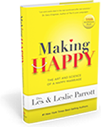You’ve just become engaged and nothing could be more wonderful and exciting. You’re walking on air, imagining the perfect wedding, a celebration of love with your fiance’s family and friends beside you, a day unfolding exactly as you have always fantasized. What bride (and groom) doesn’t begin with grand visions for this special day?
And then comes the planning. Now you have to design this perfection. So you study the magazines, write the lists, talk with your partner about what kind of wedding day you two will share. The possibilities are endlessly thrilling. And endlessly detailed. And at some point, it hits you: Planning your perfect wedding is more complicated and confusing than it seems.
Sound familiar?
As many brides and grooms quickly discover, planning your wedding is seldom a piece of cake. Just listening to all the well-meaning suggestions can overwhelm. Family, friends, wedding industry professionals — everyone has just the right idea, something you must consider. Unspoken preferences, hidden expectations and small differences of opinion suddenly surface. Will the cake be chocolate, the invitations embossed, the tables round? Who to invite and how many? What sort of food, music, post-wedding plans will there be? Few engaged couples realize beforehand that planning a wedding will be their first big relationship challenge.
Ava and Shane are getting married next summer in the San Francisco Bay Area. She’s a web designer and he’s a project manager for a tech company. They both have strong organizational skills, so they chose to plan their wedding together. This, they expected would be a straightforward process. But, like most couples who decide to share the planning, they soon discovered some surprises.
Ava told us “I had always thought that all engaged couples should plan their wedding together. But as I discovered, a fair amount of process takes place between two people planning a wedding. Even though Shane and I had lived together, I never realized how differently we made decisions. The first clash we had was over the photographer. At one point, it got so bad that I felt like saying “OK honey, just fork over the cash and I’ll see you at the alter”.
And Ava is hardly the exception.
Wedding Planning is More than Simply Organizing a Party
As a married couple and as psychologists who provide a secular, skill-based marriage preparation program, in every workshop we have given, we’ve listened to engaged and newlywed couples talk about the challenges of wedding planning. In the midst of the process, brides and grooms often begin to feel uneasy, though the moment of discomfort may come at different points. They might begin to bridle when differences emerge between them or when negotiating among family members or when the simply can’t decide what they want or don’t want. Stress can create conflict between a couple. Since the bride and groom are at the center of the event and every decision swirls around that center, the relationship will take the heat. Many brides and grooms feel this but don’t know how to cope with it and suddenly wedding planning isn’t just planning a party.
Ed and Tine are also getting married next summer at Ed’s family’s summer cottage in Washington State. Ed admitted his range of feelings and attitudes about weddings that stemmed from his being a guy and from hearing wedding horror stories from his male friends. “I was just so overwhelmed by the whole concept of planning a wedding. There’s so much baggage around weddings in our society that it made me want to back off. Traditionally, men like to take charge of planning, but weddings are different. None of my guy friends did much for their weddings. They just let the women do everything. It seems like the guys get the message somehow that all they have to do is show up for the wedding day and play husband. It’s not the right way for it to be but that’s the message guys often get”.
The vital question is how will couples deal with more “real life” issues? Will bride and groom communicate well while under pressure to make decisions and will each honor a different point of view? Will the groom work with the bride or withdraw when his fiance’s reactions seems disproportionate to the situation? What if the bride’s family wants family traditions to be honored but these run counter to the couple’s desires? How will bride and groom resolve these differences, in a way that protects their bond? In the midst of conflict, how can couples preserve their sense of connection and commitment?
Success in wedding planning is tied to understanding the emotional dynamics involved. Typically (though certainly not always) the bride is more highly invested in the wedding itself than is the groom. Because of long-held gender roles, grooms may actually feel slightly uneasy and may, in response, adopt a hands-off attitude. Other grooms may, in the face of their bride’s concerns, focus on problem solving, rather than listening to what their partners have to say. Remember, wedding planning often relies as much on the interpersonal relationships of those involved — that means on you, your fiance, your family, their family, and on individual and mutual friends — as it does on professional vendors. This means that you and your partner have the best chance of succeeding if you FIRST create a solid partnership of understanding and only then attempt to navigate through the actual choppy sea of wedding planning.
Wedding Planning is Good Practice for Married Life
Wedding planning may be the first major task that an engaged couple takes on together. Most couples overlook this simple fact and thus are unprepared for complexities that eventually arise. “Big ticket” relationship issues about which people feel strongly are involved: Love, honor, money, family, religious traditions, parental expectations, even social status come into play. Beyond that, the wedding day has, for many brides, been touted as the most important day of her life. No wonder couples feel such enormous pressure on the couple to make sure everything is just right.
As Ava told us “I thought I had gotten to know Shane really well over the first four years of our relationship. But ever since the wedding planning was officially kicked off, I’ve come to find out that there are so many differences in how we approach to things. In wedding planning, it’s all about the choices to be made. But the way we come to these choices — the process that occurs between us — has certainly been eye-opening for me”.
Wedding planning should not undermine a couple’s happiness in the months leading up to the big day. This should be a time to cherish and enjoy, and it can be a time for couples to develop their relationships in preparation for marriage. Planning a wedding may be the first chance to couples have to practice being life partners. What a better opportunity to learn how to do this? And what better opportunity to discover just what your relationship issues are?
The wedding planning process spotlights such differences as traditions, expectations, gender role preferences, interpersonal dynamics, and levels of accountabilities. The skills that are needed are the same that the couple will need to create a healthy marriage — to communicate effectively, to maintain reasonable expectations of each other, to share in decision-making and to learn how to set goals together.Once married, couples will be deciding about children, about financials, about where and how to live, about each other’s family’s involvement and dozens of other daily decisions. To have a successful marriage, couples need to learn how to make these decisions together, and wedding planning offers the perfect planning vehicle. Why not start by learning how to do that well?
Seven Steps To Wedding Planning Success
1) Recognize the Challenge, Embrace the Opportunity
Before you begin to plan, we suggest that you and your fiance sit down together to talk about the emotions you’re both feeling — those tied to the wedding especially. This is an opportunity. In other words, don’t think of planning the wedding as a mere series of planning details and decisions! Planning a wedding is much more complicated and it really helps for that to be understood before the planning begins.
View your wedding planning as an opportunity to learn how to partner, plan and share decision-making. Remember, your marriage actually begins the day after the wedding, after all the hoopla has receded and you and your partner embark on your married lives together.
Ed describes his feelings about planning a wedding: “I’d like to throw a wedding that is memorable, endearing and intimate. I want people to come away from it knowing us better and having enjoyed the experience they shared with us. But some parts I don’t especially care about — the flowers and the color schemes and the particulars about the food. I may be more involved than the average guy but I certainly don’t see myself running the whole operation.”
Because many big-ticket items are involved in planning a wedding, you’ll have many chances to learn new things about your partner and about how each of you approach complicated tasks. This is your opportunity to practice communication, conflict resolution and committing to a shared relationship.
2) Explore Your Personal Wedding Visions
This step is fun. You’ll start by simply recalling whatever you might have envisioned your wedding being when you were a child. Admittedly, more women have thought about their future weddings than have men. But almost everyone can remember weddings they attended when they were kids. What do you recall? Did you have fun? What made the event special or meaningful?
If you didn’t think much about your own wedding, why not? For many, childhood memories of marriage and weddings are shadowed by memories of their parents’ marriage. Ava admitted that this was true for her: “I never grew up with a vision for what my wedding would be like because, until college, I wasn’t sure I would even get married. I definitely wanted a family and I wanted to live with someone but marriage wasn’t part of the picture because my parents never had a good marriage. But that changed in college when I met someone who I thought would make a wonderful husband and father.”
Ava isn’t alone
Share your visions and memories with your fiance whatever they may be. Then switch roles and listen to your partner’s visions. Ask clarifying questions to help you sense more clearly what made an impression on your partner — was it the food that stood out? The clothing, jewelry, music, vows, family spats? Try to identify the core features you liked and might want to recreate from weddings you have attended in your life. Let the excitement of creating a shared vision build with each discussion you and your partner share. Now, narrow in on your own wedding. Focus in on what it is you are seeking to express — your core values, both individually and as a couple, and what you are hoping to celebrate with your wedding. Create a theme or two, like celebrating your love for each other in the great outdoors or the hidden qualities that you cherish about each other. How can you convey that theme in the ceremony, in the location, in the music or time of day or clothing? Stay open to the innumerable possibilities. As you talk, move toward more specific questions about your partner’s vision and descriptions of your own. What kind of environment would you like? Indoors or outdoors? Do you envision a nighttime wedding or one in daylight? Will your wedding be large or small and intimate?
In your earliest discussions, simply try to get a feel for what your own preferences are and a notion of those of your partner’s. Be patient with this first step. Allow adequate time to reflect on the many ideas that emerge.
Once you have a sea of possibilities before you, look at the matches between your own preferences and your fiance’s. How important are each of your preferences — what sort of weight would you give each? A unified vision will begin to coalesce, synthesizing your desires.
Don’t stop talking with each other, and let your vision ferment while your spend time reading up on various possibilities, talking to friends who are married, dreaming and remembering.You have completed this step when you and your partner have, together, devised a general idea of the type of wedding you would like to have.
3) Plan the Planning Process First
This is the most important step in our approach to wedding planning. Unfortunately, this is also the step that most couples forget. Remember this: planning a wedding takes time and effort and like any challenge, the way you meet the challenge requires planning too. Do this step first before you are drowning in the details.
Now and then couples will ask why bother with this step (that is, those who don’t simply forget). The answer is simple. If you take to heart our earlier suggestion to look at the planning as an opportunity to practice relationship skills, planning the way you will undertake this project rather than simply plunging into the process makes perfect sense. We want you to be conscious of HOW you are doing this as well as WHAT you are doing, especially since your wedding is a celebration of your union.
So what happens if you and your partner have different expectations about who will do what? What if job stress or other distractions interfere with one person’s ability to follow through on the planning process? By first discussing how you will collaborate on your wedding planning, you will establish a framework of expectations, decision-making and action based on practical realities of who you are and what you in fact are able to do. Thinking ahead of the curve will reduce misunderstandings and disappointments down the road.
Ava and Shane decided early on to wait at least one year between their engagement and wedding: “I knew we would hit some friction points over wedding planning so we decided to start the process very early”, said Shane. “And I really like to have some leisure time in the process”, Ava added, “so that I can actually enjoy it. We didn’t want to let any pressure build up because it increases the chance that unresolved conflicts might come between us”. Wise couple.
Like Ava and Shane, you’ll want first to ask each other how much control you each want over the wedding decision-making. Most couples assume they will share equally, but in reality, one person usually assumes more control.
Don’t Assume Anything!
Talk to each other and understand clearly what each of you would prefer — do you want to address all the invitations? Would you like to choose the flowers on your own? Do you know exactly who should be the photographer? Together reach an agreement at this juncture, an agreement that suits your needs as a couple and each of your individual needs.
Many partnership models for planning a wedding exist but most couples are not aware of them and fewer still decide first on a model before initiating the actual planning. And so we have provided five different models; one of these (or some combination of more than one) may work for you, but make sure you feel comfortable with the model you select, and make sure you discuss each of the options before deciding.
TRADITIONAL: The bride (and perhaps her mother) takes on most of the planning and decision-making while the groom is happy (or not) assuming a secondary role. Couples who marry in the bride’s hometown (with the wedding paid for by the bride’s parents) most often utilize this model.
ASYMMETRICAL: Either the bride or the groom agree to take on the majority of the planning and decision-making for specific reasons (often related to one or another person’s other commitments — work, ailing parent, and so forth). The person taking on fewer responsibilities may be assigned specific tasks based on particular areas of expertise.
EGALITARIAN: The bride and the groom share equally in the planning and decision-making. Each has their own “to do” lists and they share decision-making as well. A bargaining discussion results in the assignment of specific tasks, and these are usually based on each individual’s interests and/or expertise. (If your groom-to-be’s mom is a florist, for instance, guess who’ll do the flower arrangements?)
PROFESSIONAL: If both the bride and groom are exceptionally busy (jobs, children, parents, volunteer work, illness), a wedding coordinator is hired to handle the majority of wedding planning tasks; he or she will organize the wedding based on detailed discussions with the couple. These folks are experts, remember, and most couples agree to the counsel offered.
CORPORATE: Similar to the asymmetrical model, in the corporate model one person does most of the research but both bride and groom share equally the decision-making. One person gathers information, opinions, photos, ideas, and presents these for discussion and share decision-making in regularly scheduled “conferences”.
Discuss which of the above options (or combinations thereof) makes both of your most comfortable. Now, imagine out loud, the ways in which whatever model you have selected will work in relationship with your vision.
Ed and Tine decided to employ the “asymmetrical” model because Ed was committed to a full time job and Tine had some available time coming up in her work schedule as a project manager at a public relations firm. “I like to start out with a timeline to create a schedule for Ed and me that will allow us each to do the things we know best. Then I will write up a list of my ideas — what we call a creative brief in my profession — that will give a plan for moving forward with our choices. Our wedding will be pretty casual so I won’t have a lot to figure out. Some of the tasks can be delayed for a few months. Certain items will be delegated to Ed who likes negotiation. I will have my checklist and information about suppliers and due dates. My job will be to oversee the planning and then frame decisions for Ed and me to decide about it.
Again, a wise couple.
4) Create Your Action Plan
This is where most couples begin when planning their wedding. The action plan is an obvious step because it is concrete, and many are good at this step because it is involves specific and necessary actions.
First, define all the tasks involved with creating your wedding vision. Create a to-do list. Set a budget. Decide about who will be making calls to vendors, gathering information, comparing services and prices and calling references. Assign responsibilities for making decisions and dealing with contracts.
Tine and Ed were quick to point to the biggest item on their action plan: deciding about location and size of the guest list: “I have a small family whereas Ed has an enormous family — over 200 people all living in the Pacific Northwest. It really feels like I’m marrying into this big family,” Tine began.
Ed picked up the story. “Family is real important to me and I wanted to find a way to make it convenient for as many of my extended family to attend the wedding as I could. And that is what drove the decision to have the wedding at my family’s summer cabin in the Northwest. This cabin has been in my family for generations. It’s the center of my family’s life and it just made so much sense to have it there.”
“I knew his family’s sense of history around this cabin,” Tine added, “and how wonderful it would be to all the family to gather at a familiar place that will become my place as well. Since I never had a strong vision of what my wedding would be and since my family is so small, I was able to be flexible and see the practical and sentimental value of having it there. Once we decided this, we gained a clearer vision of what it would be like and how to plan for it. It all just kind of fell into place with that one decision.”
The most important item to take into consideration in terms of your relationship when developing your action plan is the implementation of the partnership model (Step Three) upon which you two have agreed. Using your list of tasks, begin to assign responsibilities to each other, assignments that reflect the selected model. Set dates and times for discussion of these items or (if you’ve selected a different model), set agreements about when you will provide your partner with feedback and deadlines for decisions. Write down everything that you have done, that you need to do and have decided you will do so that you can keep a record of your progress.
Ava described the way she and Shane implemented their action plan based on the egalitarian model. “We did end up separating who would do what research and then we would bring each other in when it came time to make a decision. For example, Shane was in charge of the bartending, music, videography and wedding insurance only because he already knows that stuff. Some of the bigger items like the location and catering we did together because they were more important and we both wanted to be involved.”
If to this point you’ve followed all four steps, you should be on the road not only to a successful wedding, but to a healthy and successful marriage.
Seven Steps To Wedding Planning Success
5. Stay Connected: Using Communication, Conflict Resolution and Intimacy Skills
Engaged couples also tend to overlook or take for granted this step — that is until a problem arises and demands their attention. We urge couples to stay connected by using specific relationship skills while they are planning their wedding. Just taking to heart the message in this article may give you a better perspective as to your purpose. Remember, your wedding is about you and your relationship and what happens between the two of you on an emotional level. Practicing good relationship skills with keeps you focused on that perspective. We all know that in planning an event as complicated as a wedding we can lose sight of the big picture, but staying aware of three skills should help You to keep that vision in place. These are:
-
- communication
- conflict resolution
- intimacy
By keeping an eye on how you are doing in each of these three areas, you will be inoculated against high conflict interactions, those that can, ultimately, undermine your connection.
Take care not to let the work of planning divide you. Whatever partnership model you have selected, it is essential that you both attend to and work on the quality of the way you relate to each other. Try to be intentional about the way you communicate planning details to your partner. Be clear. Use I statements (I telephoned 47 people this morning). Listen well (when he tells you he spent more money than he hoped to on the invitations). Don’t let your feelings overwhelm your message.Allow time for your partner to think about the news you have just rendered; leave time for questions, clarification of options, voicing of preferences. Remind yourself, always, that this is a collaborative effort, no matter the model selected. Even those who have adopted an asymmetrical model must make certain to talk about the planning and feelings around the plans as they progress.
You and your partner will have differences and these differences can evolve into conflicts if you do not handle them wisely and well. Pay attention. How do you handle differences when they come up? Which differences between you tend to lead to conflicts? How do you and your partner resolve those conflicts? Who typically breaks the logjam when one of you is upset? How do you reconnect after you have argued? How well are you staying intimate with each other, emotionally as well as physically?
Ask yourselves these questions, and answer them truthfully and often. So much about conflict resolution involves managing strong feelings and avoiding escalation, staying focused on the specific issues involved, and trusting that open and clear dialogue will, eventually, lead to resolution. Being aware that flexibility and compromise are required in nearly all resolutions will also help.
For every couple planning a wedding someone at some point feels upset and understanding breaks down.For Shane and Ava understanding broke down over their different styles of decision-making.
“The first clash we had was over the photographer,” Tine told us. “I had seen their portfolio and knew them from work so I was ready to sign the contract. I make decisions very quickly. But Shane takes so much longer to decide. He wanted to read it over and then talk it over with our friend who was also a photographer. Then Shane wanted to research different packages and options. Shane was the first to notice our differences in decision-making because I was too busy with everything to even notice that our process was breaking down.”
Shane continued. “It began with an awareness that Ava was pushing me to make a decision before I was ready. So I asked what was going on? So we finally tossed the issue out for discussion one night. We were a little defensive at first. I think we were trying to justify the positions we had taken. I was saying my way was the right way to make decisions.”
Ava followed up. “Ultimately I figured out that the right call was to give him more time in order for him to feel comfortable. I came to accept that I wasn’t going to change his mind on his style. But if I felt he was taking too much time making up his mind, I could tell him that.
“One thing I learned that helped,” Shane confided, “was to tell Ava when I would have a decision and then stick by that promise. I might have to reassure her that I would do everything myself in order to make that decision by the date I agreed to. But we also had an understanding that if we were going to lose a vendor because of my timeline, I would be willing to speed up my process to fit the practical realities.
It certainly helps to talk about it,” Ava agreed. “because what I really wanted was to know that we were making progress. Shane’s process seems very internal to me and I didn’t see that any work was getting done. And that made me nervous.”
Married and family life will always present challenges that call upon you and your spouse to come together and resolve the issue. To do this you must be clear, respectful and collaborative, and if you practice good relationship skills as you plan your wedding, you’ll find that good communication is easier in future endeavors.
6. Stay Centered: The Keys to Stress Management
One problem nearly every engaged couple we know has encountered is the sense of feeling overwhelmed, frustrated or just plain confused while planning a wedding. One person may begin to feel burned out and resentful of all the work involved, and that’s not surprising given the many issues involved. But the real question to ask yourselves is how you are going to cope with all the work and pressure? How are you going to draw on your resources — and those of your partner — to make the process more manageable? How do you take care of yourself so that planning for the best day of your life doesn’t end up making you feel more miserable than you’ve ever felt?
We strongly encourage couples — and especially those individuals who have agreed to take on the lion’s share of the planning — to devise a stress management plan. Exercise, support from friends and family, realistic expectations and letting perfectionist standards go commonly help to relieve stress during the most challenging times. Be patient with yourself, your partner and the process, and that too will help to take the edge off.
But sometimes patience, friends, exercise and reality don’t resolve the problem. Consider taking some time off. Try one week on, one week off, or call a wedding time-out on select weekends when you and your fiance just spend time together. When wedding planning begins to feel like a grind, instead of grinding through it, give yourself that needed break.
Shane and Ava had a unique way of relieving stress — SKYDIVING!
As Shane described it, “Our best stress management strategy was to go skydiving since we both like to do that. The thing about skydiving is that you can’t do it safely while thinking about something else, like wedding planning. We would just say ‘we need a break, let’s go to the drop zone’. After a day of skydiving, everything else can be viewed with more perspective.”
Not everyone is a skydiver, but everyone knows that some things help to take their minds off the tough stuff. Now and then you’ll want to follow your bliss.
The big risk for those who don’t take breaks is that you may project your stress onto your relationship and create conflict where there need be none. Be careful about this dynamic. Try not to let the stress build. Find a way to talk about your tension, upset, angst as soon as you notice tension levels rising. Talk about why whatever you’re doing is frustrating you rather than complaining or blaming your partner. If you have followed our seven steps, you’ll have fewer resentments and disappointments,and making sure you follow through on agreements will always help to eliminate feelings of hurt, anger or disappointment.
Finally, we strongly recommend that you complete most of your wedding planning at least three months before The Big Day. The purpose of all the planning is to allow you to enjoy the experience. This means you’ll want to shift from the operational side to the experience of the wedding itself. That switch may take some time, so give yourself that time. Ideally, when The Big Day arrives, you’ll be ready to let all the details go and all that good planning will deliver the day as expected.
7. Take a Marriage Preparation Class
Considering the emphasis we place on partnering while planning your wedding, our recommendation that you take a skill-based marriage preparation class should not be surprising. Implementing the ideas in this article may be sufficient, of course, and we think reading this is a good start.
We also know that every couple can benefit from learning advanced relationship skills and strategies identified in marital research; learning these skills has made an enormous difference for thousands of young couples. We hope this article will help you to devise a framework for wedding planning but we know it cannot teach you all the skills you’ll need to have not only a marvelous wedding, but also a wonderful and enduring marriage.
We recommend that you take a course early in your engagement; this will enable you to implement the tools and strategies you learn in your wedding planning. Since wedding planning can reveal so many unexpressed expectations, unacknowledged preferences and so many differences in style, particular skills are required to help you meet the challenges. Our skill-based workshop in San Francisco is designed to make sure everyone learns these skills.
As Ava explained, some of the skills she learned helped her to ease the friction that arose while she and Shane were making decisions. “One technique we learned that has been really helpful is to consider the type of feedback that Shane was looking for when he brought up an issue. Rather than just telling him what I wanted him to hear, I learned to listen more closely and to consider the kind of response he was wanting from me. When I wasn’t sure, I would ask him. Sometimes he just wanted me to listen and not tell him what he should have done differently.”
The latest marital research suggests that taking a marriage preparation workshop — especially one that emphasizes relationship skills — can reduce the chances of a couple divorcing by 30%! In this age, when divorce seems, sometimes, as chancy as a coin toss, marriage education makes great sense. But marriage preparation is not just about divorce prevention. Most people hope to have the best marriage possible, now and for the long-term. Learning how to “do marriage” makes sense. Just as many of you took driver’s education classes before you took the wheel, just as others take labor and delivery classes before giving birth, taking a marriage course before marriage can help you to be well-prepared and, as a result, happier.
We want couples to know that the best marriages are, forever, works in progress. If you hope to get the return you’re seeking, you’ll want to invest in your marriage. Everyone wants a world-class marriage, but we challenge you to work to create the marriage of your dreams.
A variety of religious and secular workshops, classes and services are available for newly engaged and newlywed couples. Ask your priest, rabbi or reverend about those services offered through your church or temple. You can also visit the Smart Marriages website at www.smartmarriages.com and click on their directory for a list of programs available in your area.
Advice For the Bride
Listen! Listen! Listen! Give your fiance chance to articulate what he thinks and feels about the wedding and planning process.
Accept that your fiance may have a different level of investment in the wedding and wedding planning process
When things go wrong with the planning, be careful not to take your frustrations out on your fiance
Be thoughtful and respectful of your partner’s point of view, even when it differs from yours.
View it equally as a process of collaboration, learning and partnership as much as an outcome that will create a wonderful event.
Advice For The Groom
Listen! Listen! Listen! Give your fiance chance to articulate what she thinks and feels about the wedding and planning process.
Respect your fiance’s emotional investment in the wedding, even if it seems a bit “over the top”.
Try to match her emotionality around the ups and downs of the planning process with a reasoned, assured stance that brings some perspective to the task.
Look for ways to be involved and helpful in the planning that is consistent with what you agreed to be accountable for. Speak up if you are uncomfortable with some decision or if you feel left out of the planning.
Look for ways to build consensus with your partner rather than focusing too much on the differences between you.
Copyright © 2004 by Drs. Patrick and Michelle Gannon.








